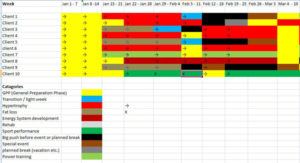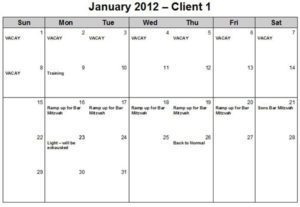"Oh, by the way I'm going to be away next week. Let's cancel our next 3 sessions."
"My kids sick so I can't come in today. Hopefully they're better by Thursday."
"My friend has a wedding in two weeks. Can we switch the program to slim down? I don't want to look bulky."
These phrases drive a stake right through the heart of our programming. All of a sudden a perfect plan agreed upon by the client is useless. You worry that the lofty goals you set during the sales meeting aren't going to be hit and they'll become disenchanted with your training. They don't renew and you're back to cold calling.
---
I used to write 12-16 week programs for my clients and they were good. It took me 1-2hrs per program. Old school Soviet coaches would have been proud. I was block periodizing, waving, pyramiding, and undulating all over the place.
It all started with a manager I had years ago. Her goal was to increase the quality of the training programs through a periodized program for each client. Every week we would meet and go over the programming. Makes sense right?
We built masterpieces. Every workout, exercise, and rep was planned out down to the tempo. The programs would transition every 4 weeks to a planned new micro-cycle. I read every book on the subject I could find ranging from Periodization: Theory and Methodology of Training by Tudor Bompa to Block Periodization by Vladimir Issurin. I became an expert in theoretical periodization and started presenting workshops on it. Then one day I had my first epiphany and everything changed...
Periodization in personal training doesn't work
It took me 3 years to figure this out so heed my advice. Don't periodize unless you're training a dedicated athlete or very advanced trainee. If that happens pick up Issurin's book and study the likes of Chek, Bompa, and Siff.
Theory and practice rarely intersect. We're dealing with real people who have real lives and real stresses. Working out is not your clients first priority. In fact, it's usually somewhere around 15. Why the heck was I spending so much time programming for clients when they forget to tell me about their vacation smack dab in the middle of a mesocycle?
When I became a terrible trainer
My pendulum swung far to the other side and it was at this point that I became a terrible trainer. I stopped planning all together. I picked 2 workouts that day. One for people trying to put on muscle and one for people trying to lose weight. Black and white. Every client did one of the two. No individualization, no progression, and no personal touch.
My clients got better results in this method then they did with individual and periodized plans. But I knew that there had to be a better way. A way to make periodization more practical. Which led to my second epiphany...
The 4 step plan
Periodization doesn't work. I know this and if you train regular people with regular jobs and regular families you also know this. Writing a 12 week plan is useless because:
- People get sick
- People's kids get sick
- Work gets busy
- Family joys or crisis happen
- Vacation
- The list goes on...
All of these things lead to acute poor nutrition and unplanned time off. It's inevitable. Periodization research is exciting to read because it works in labs and with high performance athlete. Allow me to drop some sport sociology on you. If you've never read anything by Jean-Marie Brohm I suggest you do so. He'll challenge your views and make you see organized sport in a different light. What he also recognized is that a professional athletes body is no longer owned by the athlete.
A professional athletes body belongs to the coaches, spectators, and sponsors. All the body has to do is perform at maximum efficiency in whatever way possible. That means life revolves around training. Not the other way around.
Note: If you want your views challenged pick up a copy of Sport Prison of Measured Ti by Brohm. It's no longer in print but you can buy it used or get it from the library. If you speak French you can read more of his works.
Your clients are not professional athletes. Their training revolves around their lives. To take a similar Marxist approach as the one by Brohm -- their bodies are owned by their employers and families. Their first priority is to get maximum efficiency for their company and family. Understand that when you train them YOU ARE NOT THEIR FIRST PRIORITY.
You're in the service business. Your job is to remove stress from their lives -- not insert more. Give them what they need even if it isn't a plan infused with soviet training awesomeness. Once I understood this I started to hash out a system not for periodizing. (I hope by this point you agree it doesn't work.) But for organizing and planning my clients workouts. Here's the reason for a large part of my success.
Step 1: Build a template (or steal mine)

To download the excel file for this template just click the link. Consider it a gift and if you want to repay me add me to Facebook and/or share this post or send me an email at [email protected] telling me how you used this post to help you.
Periodization chart file download
The downloadable chart is a way to track all of your clients in one convenient place. All of the weeks of the year are on the sheet. You write your clients names and choose your categories and corresponding colors however you please. You're welcome to use mine if you like. Why reinvent the wheel?
The idea is to plan 10-12 weeks in advance for your client. Not the workouts but the phases they're in. This may change and uninterrupted breaks will happen (although if you read the whole post you'll figure out how to mostly avoid them). Every time your client successfully finishes a week of training you put the forward arrow in the box. If they miss a week, put an "X" and decide whether you want to change the colors. Note for client 10 that they missed two weeks. Instead of continuing with sports performance I did a week of GPP -- then got back to the program. More on this later.
This chart also serves as a retention tool. It's nice to show clients progress. Instead of showing them workouts how about cutting out their periodization line at the end of the year and taping it to the holiday card you send them. (You're sending them personalized holiday cards right? Remember all that jazz about building your army?)
I know how hard it is to track all of your clients -- especially inactive clients. When a client comes back after time off you can quickly pull up your periodization chart and show them while hashing out a new plan.
It takes 15min each week to update the chart and voila, you're done.
Step 2: Info gathering
A template like the chart above is no good unless you have a great plan for each client. I became a more effective trainer the minute I started delving into my clients personal lives.
Remember the quotes above? How much do you hate it when a client springs on you that they'll be away the following week?
Most of that surprise can be avoided with a little forethought. I keep a calender for each client (download a free one here) 3 months in advance. At the start of each 3 month interval I arrange a 5min meeting with each client and ask them the following questions:
1. Are you taking a vacation in the next 3 months?
2. Do you have any major events coming up? (weddings, bar/batmitzvahs etc.)
3. Are you travelling for work in the next 3 months?
4. Do you have a busy season coming up? (ex. Accountants and tax season)
5. Do you have any religious holidays in the next 3 months?
6. Do you have allergies that usually act up around this time of the year?
7. Do you have any member of your family that's ill or needs special attention? (ask this depending on the strength of the relationship with your client.)
8. is there any other reason that you think your training may be interrupted in the next 3 months?

Note: I keep all of the questions open ended. I don't ask if they have any major events that will interrupt our training because I want to know everything. When you ask a question close your mouth and let the client speak. Wait for a full 2 seconds when you think they're done to make sure you get all the info. Take notes the whole time.
Step 3: Plan -- Don't periodize
You should have a good idea of your client goals and, armed with the periodization template above, now be able to set a plan to get them there. Don't think about their workouts yet. It's still big picture.
The plan varies but I'll give you one example:
You start training a new client Jan1. Their plan is to lose 20lbs by March 23. Feasible but ambitious. You already have your template ready and go over your info gathering. They have a bar mitzvah Feb 23 for a nephew and admit they will over-indulge. Beyond that there are no interruptions. They are pain free other than occasional achy knees but have limited mobility in their hips and shoulders. Here's what my chart would look like:

The gpp would be 4 weeks as it's a new client. Progression is linear and work/intensity will increase. At week 5 I would put a push to gain a baseline of muscle. 2 weeks of hypertrophy training before a really intense week of weights.
The black is a big push before the bar mitzvah. She's going to over-indulge so I've programmed it as a planned break. She'll need it as the black squares mean a lot of volume and muscle damage. This way her over-eating will help the recovery. After the bar mitzvah there will be another week of gpp (which I'd use to reassess and see how intense of a fat loss program she's ready for). The final 4 weeks before her deadline are weight loss.
This plan took me 2 minutes to hash out. I haven't considered the exercises yet but I'm sure you can figure out some workouts quickly in your head that would work for all of these phases. The visual representation of your plan makes your job easier.
It also generates a strong buy-in from your client. The plans agreed upon. I would match her up with a nutritionist and explain the need for gpp and what to expect. The nutritionist would also be given this plan so we're on the same page. The client would understand the need for the ramp up before the Bar Mitzvah and appreciate that I've minimized the effects. Lastly, the final weight loss section would be intense. The client would agree on 4 weeks of perfect eating and be ready to give it a final push.
Once the final weigh in happens on March 23rd your clients ecstatic that she lost 20lbs (or more) and you start planning your next 3 months. (After they buy a hyooge package.)
Step 4: Roll with the punches
The info gathering stage makes most annoying interruptions obsolete. It allows you to plan intensification to decrease the effect of breaks like in the example above. If you know a client has a stressful time you can plan more mobility and rest into the workouts for that period and ramp it up when they're in the right state of mind again. Most of the time it works but you know what...
Shit happens
As Coach Nick Tumminello said "We're in the service industry, our job is to give clients what they need". Know that your plan will change and be ready to accept the best case scenario. If your client is having a tough time at work then maybe a light day is a good idea even if it means pushing back a planned strength phase for 1 week.
I'm reminded of a client who was in their 7th week of a 12 week strength routine. Week 8 was a peak week and 9 was active recovery before the final and very intense 3 weeks. Shit happened. His father got sick and since training revolves around life he took a week off the gym to look after him. I went back to my periodization chart and made a simple change. It wasn't perfect but needed to be done. He still got great gains from the program and hit new PR's in the final week on the deadlift, bench press and squat. Here's his original and new charts:

The original plan with 2 active recovery weeks
A gpp was added after the missed week before starting the program again
My final epiphany
Am I adding stress to my clients lives or taking it away? I now ask myself that question with every program I write and every time I train a client.
Periodization in personal training is not high performance. It's making a plan to get your clients to their goals but understanding that what the client needs at any point in time trumps all.
Periodization chart file download
Photo credits: Model: Robin Kennedy Photographer: Darcie Kennedy











